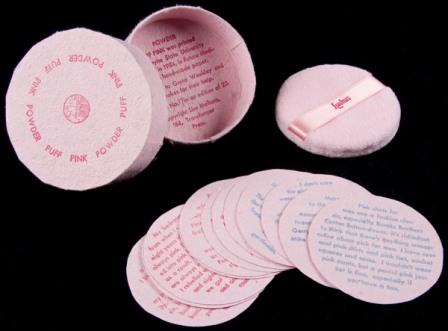Course:LIBR548F/2009WT1/Artists' Books
Definition
Artists' books are books that are made or conceived as art by artists. (By contrast, artistic or decorative books created by publishers are not considered artists' books.) Using the conventions of the book (codex, pages, spine, cover, paper, etc.), artist's books are a hybrid of exhibition, narrative and object [1] that almost always self-consciously draw attention to the structure and meaning of the book as a form. [2]

Broadly speaking, there are two types of artists' books. One type comprises limited editions or one-of-a-kind objects that employ unconventional materials and construction such as being housed in boxes or shaped containers. The other type consists of inexpensively produced books that are widely distributed and accessible. For some artists, these works are intended to democratize the art world by exhibiting the artist's work in the alternative "space" that the book provides, instead of using the hierarchical, privileged space of the gallery or art museum.
Rather than having a singular point of origin, artists' books are characterized by the intersection of a number of disciplines and the embrace of a wide range of possible materials (fur, metal, paper, wood, etc.) and content (narrative, political, aesthetic, etc.). This makes them simultaneously hard to pin down (is it a book? is it a work of art?) but also affords a level of richness and possibility that has engaged artists from almost every identifiable art movement in the last century. [3]
History and development
Although artists have been involved in the creation of books for as long as books have existed, the term "artists' book" only appeared in 1973 and artists' books are primarily associated with the twentieth century.
Predecessors to artists' books include British artists like William Blake (1757-1827) and William Morris (1834-1896) who produced exquisitely crafted artistic books combining text and image. In Russia, Futurist artists such as Vladimir Mayakovsky (1893-1930) and El Lissitszky (1890-1941) created limited edition literary projects that combined typography, photography and collage, while in 20th century France, original prints by artists such as Picasso, Matisse and Chagall were brought together with text in limited edition illustrated books known as livres d'artistes.
Artists' books as they are known today really began to flourish after 1945. The format and distribution possibilities of the book gave artists increased creative control and allowed them to use books as performance and exhibition spaces.

Fluxus artists in the 1960s produced publications that involved book-making processes such as gluing, stapling, folding and trimming. Pop artists such as Andy Warhol and Claus Oldenburg also produced books, as did minimalist and conceptual artists who were seeking independence from the art gallery establishment.
In the 21st century, artist's books continue to challenge the idea of the book and reinvigorate bookmaking practices, as evidenced by the increasing number of available post-secondary book art and print culture programs. This appreciation of and emphasis on the book as material object is particularly resonant at a time in history when more people are meeting their information and entertainment needs through digital materials than ever before.
Artists' books online
The best way to understand artists' books is to physically spend time reading and handling them; however, this is not always possible due to their collectible nature and the fact that they are often housed in museums and rare book collections. Despite the fact that artists' books offer the potential for distribution outside of gallery and museum settings, the reality is that they are not always readily accessible and much of the public still remains unaware of their existence.
Although the intimate, tactile nature of artists' books cannot be fully experienced digitally, the trend towards digitizing artists' books can provide visual access to what are often expensive or fragile works of art without risking the damage that can come with physical handling.
- Library and Archives Canada
- National Art Library's Victoria and Albert Museum
- Herron Art Library at the Indiana University and Purdue University, Indianapolis
- Zybooks Gallery
- State Library of Queensland
- Otis College of Art and Design
- Artists' Books Online
- Science and the Artist's Book

Notes
[1] Klima, Stefan. Artists Books: A Critical Survey of the Literature. New York: Granary Books, 1998: 34
[2] Drucker, Johanna. The Century of Artists' Books. New York: Granary Books, 2004: 4.
[3] Drucker, Johanna. The Century of Artists' Books. New York: Granary Books, 2004: 1.
Recommended resources
Bury, Stephen. Artists' Books: The book as a work of art, 1963-1995. Aldershot, England: Scolar Press, 1995.
- This book contains a chronological bibliography of artists' books from 1963 through 1994 accompanied by black and white photographs of selected examples. The bibliography is preceded by seven mini-essays that provide a historical and conceptual background to artists' books followed by a Chronology dating from 1714 to 1992, a Glossary, a General Bibliography and an extensive Index.
Drucker, Johanna. The Century of Artists' Books. New York: Granary Books, 2004.
- Drucker is a book artist with a passion for the form. This new edition (originally published in 1994) is organized into 14 chapters and illustrated with black and white photos throughout. Drucker considers various aspects of artists' books, including their history and precedents, their simultaneous existence as mass produced multiples and rare objects, the role of text and narrative, artists' books as performance, exhibition and agents of social change, and the future of artists' books.
Ellen Firsching Brown. "Beyond Words: Artists' Books." Modernism Magazine (2008). http://publishing.yudu.com/Apt5o/MV11N3/resources/56.htm.
- This online article is a brief and accessible introduction to artists' books accompanied by full colour illustrations of salient examples. It looks at the precursors to artists' books, their rising popularity in the 20th century and the 1970s in particular, the state of artists' books today, and offers tips on what to look for when collecting artists' books.